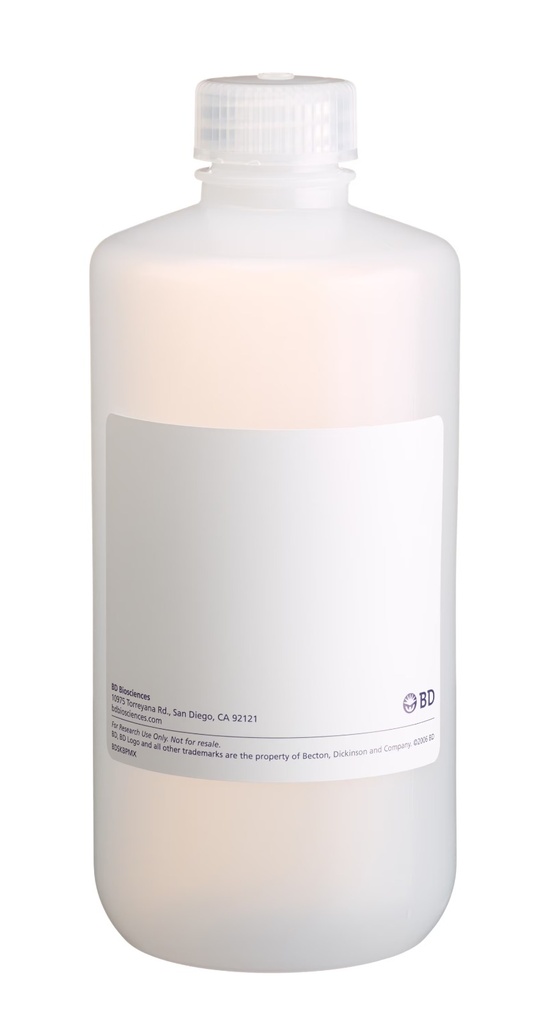Specifications:
| Application | Flow Cytometry |
| Storage Temperature | Room Temperature |
| Product Type | Buffer |
| Product Brand | BD Biosciences |
| Product Grade | Molecular Biology |
The BD Pharmingen™ Stain Buffer (FBS) is a specially formulated buffer designed for optimal performance in immunofluorescent staining of single-cell suspensions. This buffer ensures enhanced cell viability, stability, and fluorescence intensity, making it an essential tool for flow cytometric analysis of cells from lymphoid tissues, bone marrow, peripheral blood, or cultured cells.
Key Features
- Optimized for Flow Cytometry:
- Ideal for dilution, application of fluorescent reagents, cell suspension, washing, and storage before analysis.
- Neutral pH for Stability:
- Formulated with pH 7.4 buffered salt solution (DPBS) to maintain cell viability and support fluorescence signal stability.
- FBS Supplementation:
- Enriched with heat-inactivated fetal bovine serum (FBS) proteins to enhance cell survival and reduce background staining.
- Enhanced Fluorescence Intensity:
- Maintains fluorescence signal intensities, especially for pH-sensitive fluorochromes like fluorescein isothiocyanate (FITC).
- Contains Sodium Azide (NaN3):
- NaN3 acts as a metabolic inhibitor to:
- Prevent redistribution of cell surface antigens caused by antibody crosslinking.
- Maintain fluorescent signal stability during analysis.
- In combination with low temperatures, NaN3 prevents antigen shedding or internalization.
- NaN3 acts as a metabolic inhibitor to:
- Heat-Inactivated FBS:
- Serum proteins are heat-inactivated at 56°C for 30 minutes, ensuring minimal interference with antibody binding or fluorescence signals.
Applications and Use Cases
1. Immunofluorescence Staining:
- Enables precise staining of single-cell suspensions from various sources:
- Lymphoid tissues.
- Bone marrow.
- Peripheral blood.
- Cultured cells.
2. Flow Cytometry:
- Supports cell suspension, washing, and storage for flow cytometric analysis while preserving fluorescence signals.
3. Fluorescent Reagent Dilution:
- Acts as a stable medium for the preparation and application of fluorescent reagents.
4. Signal Optimization:
- Enhances fluorescence intensity, particularly for pH-sensitive fluorochromes like FITC.
Buffer Composition
- DPBS (Dulbecco's Phosphate-Buffered Saline):
- Ensures a neutral pH of 7.4 for maintaining cell viability and buffer stability.
- Heat-Inactivated Fetal Bovine Serum (FBS):
- Improves cell viability and reduces non-specific background staining.
- Sodium Azide (NaN3):
- Inhibits antigen redistribution and maintains fluorescent signal intensity during storage and analysis.
Advantages
- Preserves Cell Viability:
- FBS supplementation ensures minimal cellular stress and supports cell survival during preparation.
- Enhances Fluorescent Signal Stability:
- Neutral pH and NaN3 maintain stable fluorescence intensities, even for pH-sensitive fluorochromes.
- Reduces Antigen Redistribution:
- NaN3 prevents antigen shedding and internalization, preserving the accuracy of antibody binding.
- Ready-to-Use:
- No additional preparation is required, simplifying workflows.
- Versatile Applications:
- Suitable for various cell types and sources, including immune cells and cultured lines.
Storage and Handling
- Storage Conditions: Store at 2–8°C to maintain buffer integrity.
- Shipping Conditions: Shipped under cold or frozen conditions.
- Shelf Life: Refer to the product label for the expiration date.
Why Choose BD Pharmingen™ Stain Buffer (FBS)?
- Consistency: Provides reliable and reproducible results across experiments.
- High Performance: Maximizes fluorescence intensity and stability during flow cytometric analysis.
- Trusted Brand: Developed by BD Pharmingen™, a leader in immunological reagents and flow cytometry solutions.
The BD Pharmingen™ Stain Buffer (FBS) is a highly effective solution for immunofluorescent staining and flow cytometry. Its unique formulation, incorporating heat-inactivated FBS and sodium azide, ensures enhanced fluorescence stability, antigen preservation, and ease of use, making it an essential component for researchers in immunology and cell biology.




 0
0
